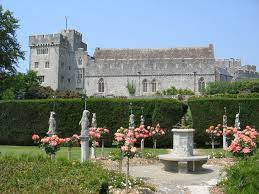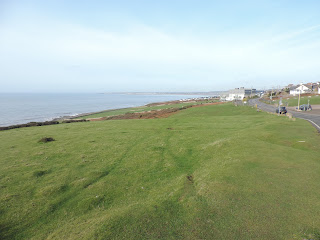I’m not sure if every other cyclist in Wales feels the same,
but for the last 9 months The Fairfield Flyer, AKA Colin and I have been
trundling along the same routes around the Vale of Glamorgan, always starting
and finishing at our homes in Llantwit Major, which, whilst enjoyable and
allowing us to get out and about, has become a little monotonous.
So, with the weather sunny and a cold northerly breeze blowing, we decided to try something different and venture further afield and experience some of the National Cycle routes that South Wales has to offer. To save a little time (we needed to be back to watch the football at 3pm!) we loaded our bikes onto the early morning train to Bridgend where, upon arrival we headed to a well-known fast food chain emporium for sustenance in the form of a bacon roll!
Fuelled up and ready to go our route took us passed Bridgend Rugby Club which boasts JPR Williams as one of its former players and follows the banks of the Ogmore river. NCR 883, The Ogmore Valley Trail, is well surfaced and along the trail the remnants of the Ogmore Valley Railway are visible. This railway was used to transport the coal mined in Nantymoel down the valley to Porthcawl on the coast. The gentle rising track passes through the small villages of Ogmore Vale and Wyndham, once thriving mining communities before finishing in Nantymoel which sits proudly at the top of the valley and where the 1964 Olympic Long Jump Gold Medallist, Lyn “The Leap” Davies hailed from.
The gradual ascent from Nantymoel up the winding A4061 to
the summit at Bwlch -y - Clawdd (450m) was achieved with much more of an effort
from Colin on his Hybrid Pinnacle than from me on my Riese & Muller
Supercharger 2 and as we rounded the corner at the top we were greeted by a
gusting icy wind, spectacular views down to Treorchy and the welcome sight of a
refreshment van just pulling into the layby!
The road was originally a dead-end
from Bridgend along the Ogmore Valley and was built in the 19th century, but
concerns over travel difficulties, the environment and unemployment in the
Rhondda following the decline in mining, led to a series of mountain roads
being planned. The road was initially extended over the Bwlch-y-Clawdd towards
Treorchy in 1928.
Refuelled with tea and Welsh Cakes
we continued with a short but steady climb along the A4107 towards Port Talbot
and down into the Afan valley. The
descent from the summit must be one of the best rides in Wales! Fast and smooth
with Alpine like turns, we arrived very quickly in Abergwnfi where we joined
the cycle track which joins up with NCR 887 Afan Valley Route at Cymmer. We
glided along the well maintained cycle track with little effort, freewheeling
down the gentle gradient passing through woodlands and the former mining
communities of Pontryhdyfen, birth place of Richard Burton, and Cwmafan.
Our arrival in the bustling town Port
Talbot had us searching, somewhat in vain, for the NCR 4, which would take us
back to Bridgend via Margam. After an
unintended detour to Aberavon beach, we eventually found our bearings and
headed east past the imposing structures of the steel works and connected with
our intended route. NCR 4 stretches over
430 miles from Fishguard to London and the section from Pyle to Aberkenfig on
the outskirts of Bridgend passes through the Parc Slip Nature Park. Once a mine, that witnessed a disaster of
epic proportions when in August 1892 an explosion killed 112 men and boys, the
area has been transformed into a tranquil area that is now shared by bird
watchers, joggers, cyclists and walkers alike.
To conclude our Good Friday adventure,
we decided to complete our journey back to Llantwit Major by bike taking in the
NCR’s that we had come to know and love so much during lockdown – good old NCR
88 through Ewenny, Wick, St Donats and finally Llantwit Major…. Just in time
for the football and to plan our next trip further afield.


















